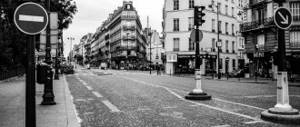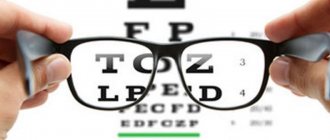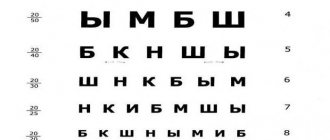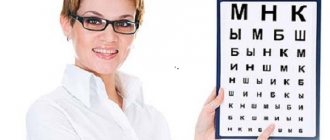An vision test is a mandatory diagnostic procedure that is important to undergo at least once a year. Prevention should not be neglected, especially in our time, when a person constantly puts strain on his eyes by looking at the screen of a smartphone, computer, TV and other devices. If there are problems with vision, then prevention must be taken more often.
For diagnostics, specialized tables are used, which differ somewhat in their testing methods and purpose. Some types are used only for children, others are used to identify color vision defects. Therefore, it is advisable to understand what tables exist and what they are used for.
Vision diagnostics must be carried out at least once a year, even if there is no nearsightedness, farsightedness or other problems.
What are tables for?
To determine a person’s visual acuity when choosing contact lenses, glasses, or for prevention, special tables are used. Diagnosis by an ophthalmologist always begins with viewing tables, which come in different types and require different approaches when checking.
Undoubtedly, today there are more advanced testing technologies using specialized devices. However, in some situations, the machine cannot show such an accurate result as a regular check on the table.
What it is?
Visometry is a completely quick and accurate diagnostic method that does not require any preparation. It is a technique for testing visual acuity, based on the use of special tables by an ophthalmologist.
Visual acuity refers to the ability of the eye to see two separate objects at a minimum visual angle, which is measured in minutes. The visual angle is taken as the norm, which is equal to 1 minute, and is denoted by one.
The table for studying visual acuity is a large white poster with black signs of different sizes depicted on it. These signs in ophthalmology are called optotypes .
The table should be located at a distance of 5 meters from the subject. The visometry procedure is carried out strictly in a sitting position. Visual acuity is checked for each eye in turn. The patient covers one eye with a white plastic spatula, and the doctor asks him to recognize the different optotypes.
You can check your vision online using tables here
Video:
How to check vision using tables?
Methods for diagnosing the eyes vary somewhat, depending on which table the ophthalmologist uses. But in general the procedure follows the same principle:
1. A person is seated opposite the table at a certain distance. 2. The doctor points to a line or symbol on the table and asks the person to name it. 3. If a person can clearly distinguish the indicated symbol or line, the doctor points to a smaller font and so on until the patient sees a line indicating 100% visual acuity. 4. If at any stage the patient cannot see the symbol in the line, or sees it blurry, the ophthalmologist needs to put on special glasses with replaceable lenses. 5. The lenses are changed and the testing procedure is repeated until the patient clearly sees the required lines. 6. Based on the number and strength of installed glasses, visual acuity is determined and a prescription for glasses or contact lenses is written.
The distance of the vision test depends on which chart the doctor uses. It is important to choose it correctly, otherwise the effectiveness of the test will tend to zero.
Your eyesight should be checked by a professional ophthalmologist, in compliance with all rules and regulations. Home tests will not provide an accurate result.
Dimensions of Golovin and Sivtsev tables
The dimensions of the optotypes (letters and rings) of the Sivtsev and Golovin tables are: 70 mm – the height of the first line, 35 mm – the second, 10 mm – the last. The dimensions are determined by the formula: 7 mm divided by “V” (the line that needs to be calculated).
If you do not have the opportunity to print a full-size Golovin table to test visual acuity, you can do this on a standard sheet of A4 paper, but in this case, reduce the distance (D) indicated in the left column by 2 times, i.e., instead of 5 m – 2.5, instead of 2.5 – 1.25.
Types of checks
Sivtsev table
A classic diagnostic vision test tool used by most doctors. It looks like a set of letters of different sizes, which are placed on 12 lines. To the left of the letters is written the distance from which the patient should clearly see this row. On the right side, visual acuity in units of units is indicated. During the test, vision is defined as one hundred percent if the patient clearly sees the 10th line from 5 meters.
Golovin table
The principle of operation is similar to Sivtsev’s table, however, in each line, instead of letters, there are signs in the form of circles with breaks on a certain side. Suitable for diagnostics in situations where a person has memorized Sivtsev’s table. Rings are much more difficult to remember; with poor vision, it is difficult to distinguish the location of the break on the ring, so this tool often gives an accurate result. The use of Golovin tables is possible both in combination and as an independent tool.
Orlova table
It is used to test the vision of a child who does not yet know the letters and does not always understand the Golovin table. For testing, optotypes with images of animals, plants, equipment and other signs familiar to every child are used. The verification principle is the same as that of the standard Sivtsev table.
Snellen chart
A foreign version, on the basis of which the Sivtsev table was developed. In Russia it is practically not used for vision tests. Diagnosis is carried out from a distance of 6 m, but the distance is calculated in feet. Consists of only 11 lines with Latin letters. Visual acuity is expressed as a fraction. The numerator of the fraction indicates the distance in feet to the table, and the denominator indicates the distance (also in feet) from which a person with 100% visual acuity is able to read the lines.
Rabkin tables
The set of images for detecting color blindness consists of 27 main images (48 including additional ones). In complex multi-colored images, a person should see certain signs or numbers. If there are any defects in color perception, then not all characters will be recognized. Based on a check using these tables, ophthalmologists divide people into 3 categories:
- trichromates;
- deuteranopes;
- protoanopov.
A trichromancer is a person without visual impairments who is able to see all hidden signs. Deuteranopes are people who lack vision in the green spectrum. Protoanopes - difficulties with the perception of the red spectrum.
Eye test table (Golovin table)
Good day, dear readers!
Previously, we have already looked at a table for testing vision - the Sivtsev table, but today we will continue to consider existing tests for testing vision, and next in line is the Golovin table.
Of course, the best option is to visit an ophthalmologist (ophthalmologist), who will not only check your vision, but also, if necessary, give useful recommendations on maintaining or improving visual function. However, if this is not possible, then this article will help you check your vision at home yourself, online, using a computer.
Professional visual acuity test
Eye examinations should be performed by a professional ophthalmologist under appropriate conditions, observing all rules, regulations and distance from the table. In our optical salons, visitors can check their visual acuity free of charge before choosing glasses or contact lenses.
We offer:
- free diagnostics;
- wide selection of frames, glasses, contact lenses;
- making everyday glasses according to prescription;
- selection and production of special optics (for computers, reading, etc.).
We will help you solve vision problems, select the appropriate correction tool for you, and give recommendations and tips regarding eye health.
Home eye test for astigmatism
The simplest and most understandable test for astigmatism at home is the Siemens star. Expand the image to full screen, step back 3-5 steps and start checking. Each eye should be tested separately, as in the case of testing visual acuity, cover one eye with your palm, but do not squint.
Normally, a person sees a circle with both eyes. However, if you have astigmatism, during the test you may notice that the picture has changed to an ellipsoidal shape. With this visual disturbance, the rays seem to blur and overlap each other without reaching the center.
Sometimes a person notices an inversion: the background becomes black, and the rays become white. This effect may also indicate the presence of astigmatism.
However, the results of the test can be influenced by various factors, including lighting and the degree of eye moisture! Therefore, you cannot rely on an online test alone; it is necessary to confirm the diagnosis at an appointment with an ophthalmologist.
Sign up for a free vision test
How to prepare for the test?
You should check your vision for astigmatism in the morning. Correction devices must be removed at least 10 minutes before the test. The room should be sufficiently lit, and the brightness of the monitor should be dimmed to medium values.
How often should I repeat the check?
Incorrect perception of the Siemens star may indicate not only astigmatism, but also other visual impairments. You should repeat the check every few months, but make sure that the conditions - lighting, distance to the monitor, well-being - do not change.
Sivtsev table
For adults and children who can read, Sivtsev’s diagnostic table is used to check the visual acuity of each eye separately. It contains letters, the size of which decreases with each new line. The more lines the patient sees, the better his vision function.
The table uses letters of the Russian alphabet, arranged in a chaotic order. Next to each letter are the following symbols:
- D – the minimum distance required for a person with normal vision to recognize a given line in the diagnostic table (the distance decreases with each subsequent line, for the first – 50 m, for the last – 2.5 m);
- V is a designation of the quality of visual acuity that is inherent in a patient seeing a certain line, that is, if a person recognizes only four lines, visual acuity will be assessed at 0.4 units.
To properly perform a diagnostic test, the ophthalmologist's office must be well lit. A person sequentially closes first one eye, then the other to test the recognition of the number of lines. This is because the visual acuity of each eye may be different.
The disadvantage of the method is that the patient can learn all the lines in the diagnostic table by heart. But if the doctor notices that a person is naming symbols from memory, he may randomly point to different letters. This method can be used by schoolchildren when they do not want to wear glasses, or by men who do not want to join the army. If he still doubts the reliability of the study, he can check the quality of a person’s vision using Golovin’s diagnostic table.










